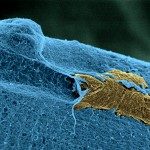Link to Pubmed [PMID] – 18586235.
Cortex 2008 Sep;44(8):962-74
Functional neuroimaging and studies of brain-damaged patients made it possible to delineate the main components of the cerebral system for word reading. However, the anatomical connections subtending the flow of information within this network are still poorly defined. Here we study the connectivity of the Visual Word Form Area (VWFA), a pivotal component of the reading network achieving the invariant identification of letter strings, and reproducibly located in the left lateral occipitotemporal sulcus. Diffusion images and functional imaging data were gathered in a patient who developed pure alexia following a small surgical lesion in the vicinity of his VWFA. We had a unique opportunity to compare images obtained before, early after, and late after surgery. Analysis of diffusion images with white matter tractography and voxel-based morphometry showed that the VWFA was mainly linked to the occipital cortex through the inferior longitudinal fasciculus (ILF), and to perisylvian language areas (supramarginal gyrus) through the arcuate fasciculus. After surgery, we observed the progressive and selective degeneration of the ILF, while the VWFA was anatomically intact. This allowed us to establish the critical causal role of this fiber tract in normal reading, and to show that its disruption is one pathophysiological mechanism of pure alexia, thus clarifying a long-standing debate on the role of disconnection in neurocognitive disorders.

